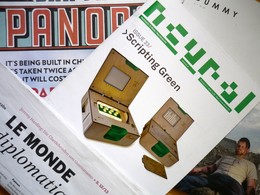Mirko Tobias Schäfer / Assistant Professor
University of Utrecht Department for Media and Culture Studies
Mirko Tobias Schäfer / Assistant Professor
University of Utrecht Department for Media and Culture Studies
Le Diplo is an outstanding monthly newspaper providing elaborate opinion and solid analysis of culture and politics. With its in-depth articles written by excellent journalists and scholars, Le Monde Diplomatique provides a great resource for left-liberal citizens and offers a critical view upon the dominant power structures. Furthermore, Le Diplo is working to emerge as a global newspaper, being available in more than 25 languages and published in 72 different editions, of which 46 are print editions with a total of 2.4 million copies, as well as 26 electronic editions.
A prototype for a high quality paper for the larger urban areas with a sufficient audience of hipsters, creative industry, and highly educated people, this large-format magazine provides sophisticated, well-reswearched journalism on a variety of issues. Instead of the usual cooking section, this magazine provides a great article on
road kill meat recipes and a detailed description on how to bone and barbeque a lamb. The quality of large paper formats is emphasized in nicely shot posters and pages so well designed that you might want to hang them on your wall. McSweeney's San Francisco Panorama started out as an experiment to prove that it is still possible to market a quality paper and earn a profit. Making this process transparent, the paper lists the complete production cost. It would be very welcome indeed if a media entrepreneur could start a similar magazine for the European hipsters who are oscillating between the various large cities from London over Amsterdam to Berlin.
Alessandro Ludovico likes to call himself a dedicated paper guy who enjoys the tactile experience of reading a print magazine as much as designing and editing one. Neural, a quarterly publication, provides the contemporary screenager off screen with news on hacktivism, media art, electronic music and well written articles on various issues of digital culture. Deliberately published on paper, Neural is a great example that an online version does not replace the traditional paper. Sitting in a train or on a terrace and browsing through the magazine, the reading experience is very different from visiting the also excellent Neural website. On the website the choice of articles to read is far more deliberate than the accidental stumbling upon a piece on a weird art show in the paper version.
The German magazine Dummy appears monthly and revolves each month around one main topic, such as Nuclear Energy, Love, Speed, Crime, etc. Articles are well researched and excellently written and accompanied by great photo art. From every page Dummy radiates that they just do not care what the marketing people say about media. The Dummy team seems to produce the paper they would love to find in a store but that none of the lame media producers has been able to accomplish.
The Dutch daily free paper De Pers is an idealistic venture of brave journalists and even braver entrepreneurs. It holds only a small market share against the two major free papers, Spits! and Metro, which pour their utterly cheap content on the busy and distracted public transport passengers. As a daily paper, De Pers makes a difference and provides the interested audience with intelligent articles on current events, national and foreign affairs, and everything else dailies usually cover. But De Pers does it according to its slogan, "Gratis, maar niet goedkoop" - Free, but not cheap. If the educational system continues in its decline the emerging idiocracy will make a quick end to this astonishing project. As an optimist I wish that Enlightenment will continue to spread and more students and maybe even some totally bored office people might increasingly choose the smarter free paper to spice up their daily train travels.
The above-mentioned papers are standing out from the daily torrent of cheap, over-advertised free papers and glossy magazines promoting yet again the most boring fashion and faces. These papers show proper craftsmanship in testing the paper medium to its limits and holding on to uncompromising quality journalism and aesthetic ideals. In my opinion many magazines and newspapers struggle precisely because they lack these qualities. Copy-and-paste from news agencies does not replace journalism but rather turns newspapers into boring and predictable containers for meaningless content. Not taking the media-specific aspects seriously is another problem. When media corporations want to differentiate from competitors they should remember McLuhan's best-known one-liner: The Medium is the Message. If a newspaper can in fact be easily replaced by the average press agency news feed, somebody did not properly think about both content and medium specific aspects. Those papers deserve nothing else than to vanish into oblivion. The others will hopefully find sufficient readers to stay in business and continue with publishing innovative and high quality print papers.

While the new materiality of digitized media content has radically challenged the music and film industry, the publishing industry seemed to feel comfortable neglecting the changing reality of the media business. But then major news papers blamed their decreasing revenues on freely accessible web content, and paint a dark picture of a future lacking proper journalism and diverse media, most ominously, the vanishing of printed papers and magazines. Time for a reality check: It appears that there is not only a demand for print but there are also smart publishers producing innovative print products.